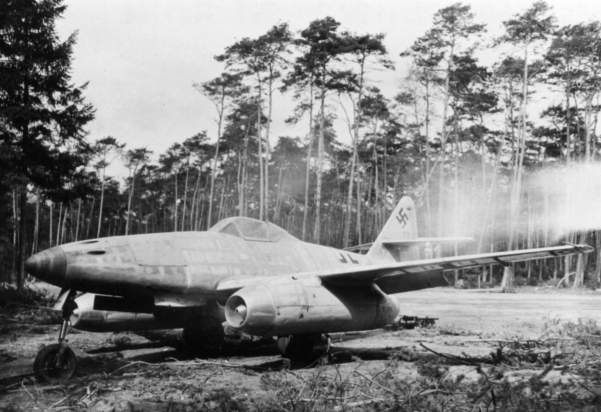
The Messerschmitt Me 262 Schwalbe (‘swallow’) was the world’s first operational jet fighter and the fastest aircraft of World War II. Its development started back in the mid 1930s, when the German engineer Hans von Ohain began work on jet engines, but was not formalized into a specification for a twin-engined fighter until 1939. The aircraft had a difficult development period, partly because of the enormous complexity of realizing such a radical experimental design and partly because of skepticism among senior figures in the Luftwaffe. Despite slashed budgets and institutional indifference, work on the prototype progressed steadily, and on 18 July 1942 it made its first jet powered flight.
Due to continuing problems with the Me 262’s engine, the aircraft was not ready for operational use until April 1944. The first unit to be equipped with the 262 was Erprobungskommando 262, also known as Commando Nowotny after the fighter ace Walter Nowotny, its leader. During its operational testing, the Me 262 achieved a kill-to-loss ratio of more than 4:1 – better than any other German aircraft. By January 1945, several fighter squadrons had been converted to the new aircraft.
With a top speed some 100mph faster than that of any Allied fighter (aside from the rarely-seen British Gloster Meteor jet fighter) the Me 262 was deadly in aerial combat. German pilots learned to approach allied formations in a shallow dive, blast their way through with their four 30mm cannon, and then zoom away before the enemy could react. The only hope Allied pilots had of countering the Me 262 was to lure the German pilots into a close-range dogfight, where its slow-acting throttle and wide turning circle made it vulnerable to more nimble piston-engined fighters.
Although its combat record was impressive (around 540 Allied kills before the end of the war), the Me 262 ultimately came too late to have any noticeable effect on the course of the air war over Europe. The Me 262 was an important influence on the design of post-war jet fighters, particularly in the United States, where most of the project’s engineers relocated after the war.
Specifications
- Manufacturer
- Messerschmitt A.G
- Type
- Jet engined fighter
- Length
- 10.6m (34ft 9in)
- Span
- 12.6m (41ft 6in)
- Height
- 3.5m (11ft 6in)
- Maximum Speed
- 900km/h (559mph)
- Service Ceiling
- 11,450m (37,565ft)
- Range
- 1050km (652 miles)
- Crew
- 1
- Powerplant
- 2 x Junkers Jumo 004 B-1 turbojets
- Armament
- 4 x 30mm MK108 cannon
- Bomb Load
- 2 x 250 kg (550lb)
- First Flight
- 18 July 1942
- Initial Climb
- 1200m (3900ft) per min
- Weight (empty)
- 3795kg (8366lb)
- Weight (loaded)
- 6473kg (14272lb)
